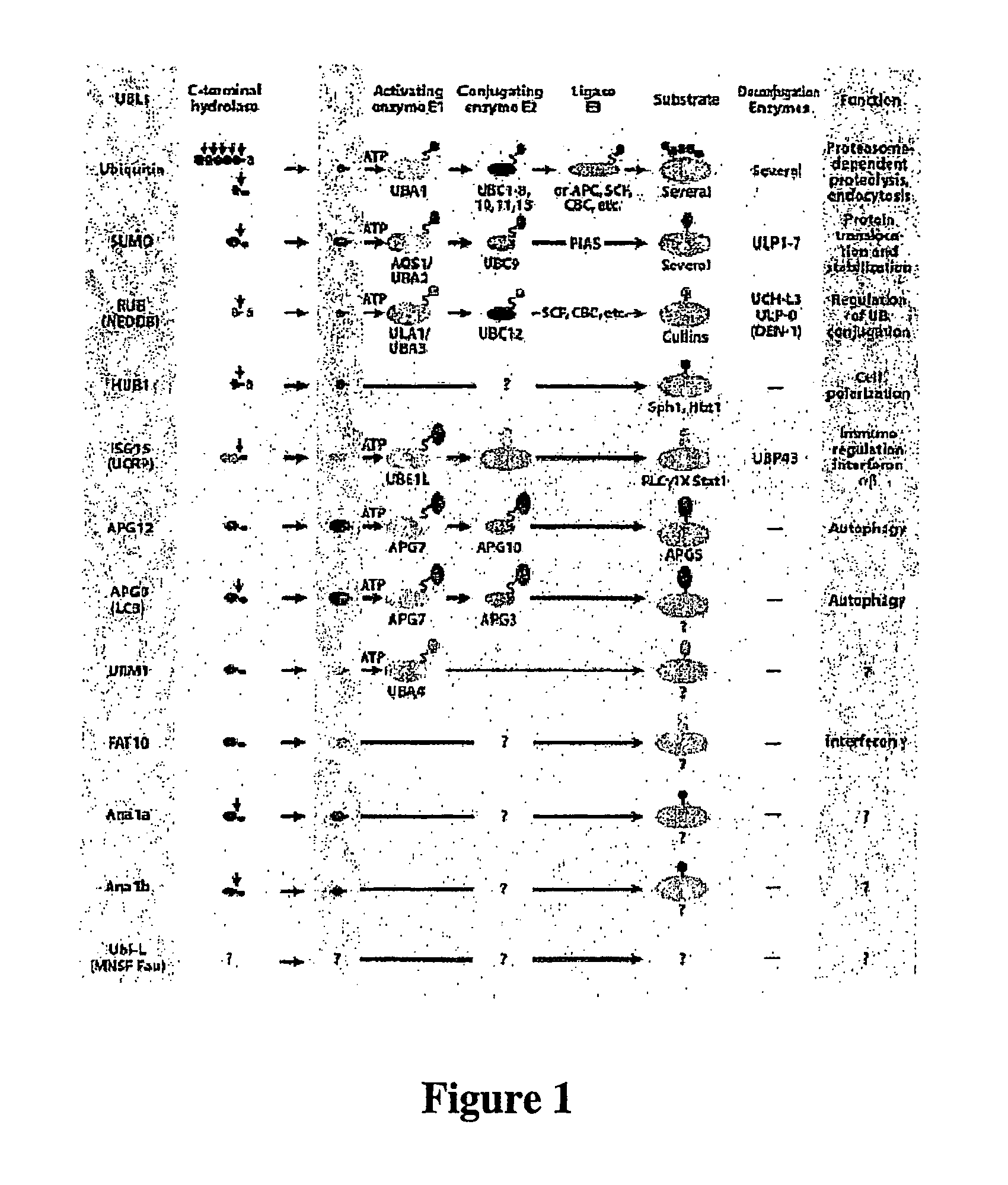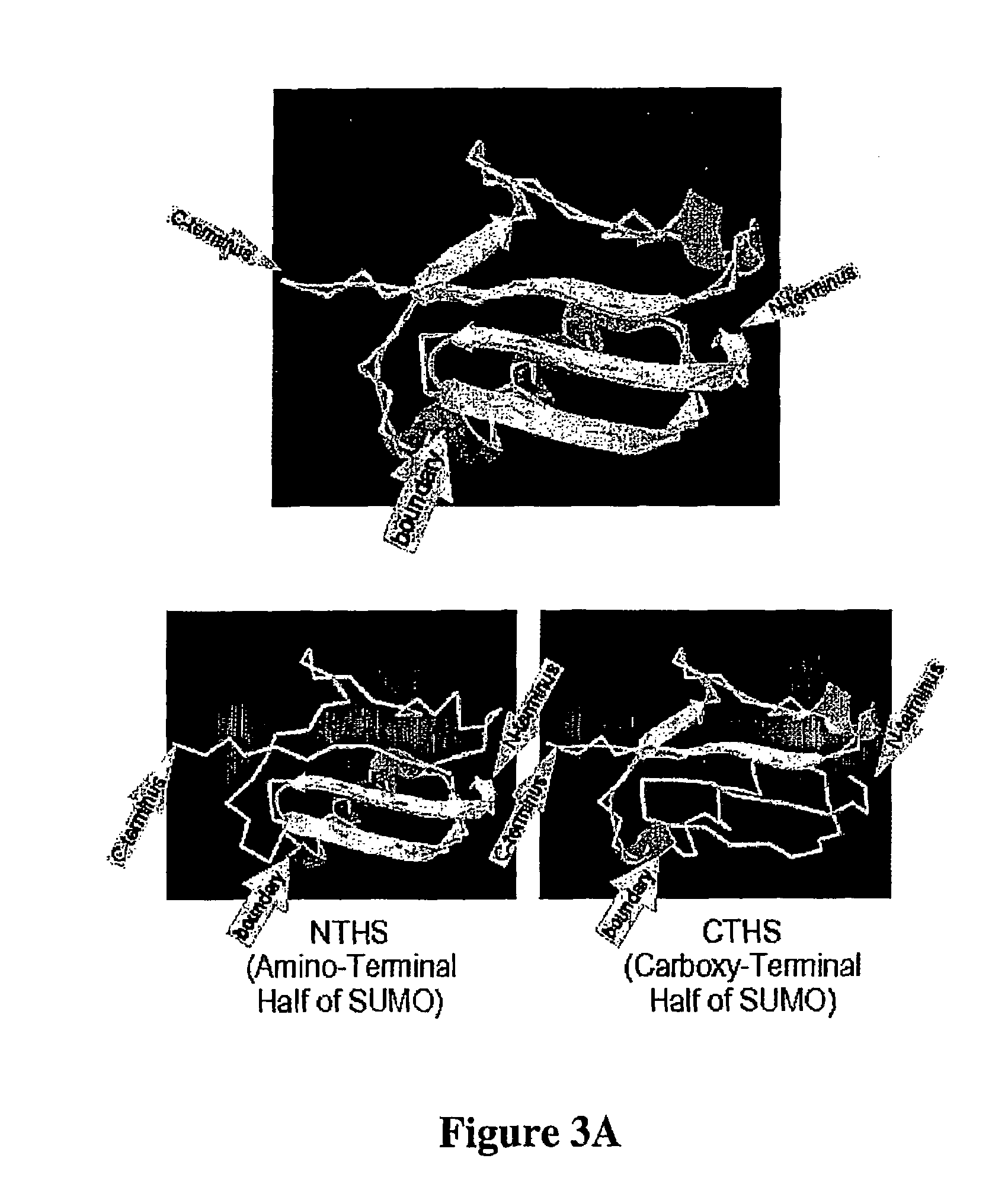Methods and compositions for enhanced protein expression and purification
a technology of enhanced protein expression and purification, applied in the field of recombinant gene expression and purification of expressed proteins, can solve the problems of inability to uniformly express and purify, hampered functional genomic studies, heterologous gene products failing to achieve the correct three-dimensional conformation, etc., and achieve the effect of enhancing the expression level of a protein of interes
- Summary
- Abstract
- Description
- Claims
- Application Information
AI Technical Summary
Benefits of technology
Problems solved by technology
Method used
Image
Examples
example i
Attachment of Carboxy-Terminal Half of SUMO (CTHS) to N-Terminus of GFP Enhances the Expression of the Protein in E. coli
[0108]The design and construction of all the pET vectors expressing GFP has been described above. The DNA sequences, accession numbers of the SUMO, CTHS, GST, GFP, the fusion constructs, plasmid maps, and translation frames are shown in FIGS. 12-24. FIG. 5 shows the expression pattern of 6×His-GFP, 6×His-SUMO-GFP, 6×His-CTHS-GFP, GST-6×His-SUMO-GFP, and GST-6×His-CTHS-GFP. Induced E. coli cells were ruptured by sonication and soluble proteins were analyzed on SDS-polyacrylamide gels. The stained gel shows (FIG. 5A) that the fusions were soluble. Un-fused GFP is generally poorly expressed in E. coli. The data show that SUMO and CTHS with and without attachment of GST enhance the expression level of GFP to varying degrees. FIG. 5B shows GFP fluorescence in approximately 0.1 mg of soluble protein in a final volume of 40 μl using Fluoroscan Accent FL fluorometer (Lab...
example ii
Attachment of Carboxy-Terminal Half of SUMO (CTHS) to the N-Terminus of GFP Enhances the Expression of the Protein in Yeast Without Cleavage
[0110]The design and construction of all the Yep-based plasmids expressing various fusions of GFP and the methods for protein expression analysis have been described in detail above. Briefly, the constructs initially made in the pET24 vector were excised and recloned into the YEp vector. The transformants were selected on medium lacking tryptophan. Expression was induced for three hours and the proteins were analyzed by western blot with anti-GFP antibodies.
[0111]FIG. 6 shows a representative blot of GFP-fusions produced by yeast when expression is performed in YPD nutrient rich medium. There was a 10-20 fold increase in expression of GFP following fusion with CTHS. However, a nearly 50-fold increase in GFP production has been observed when cells were induced with 100 μM copper sulfate in synthetic medium. This variation in fold-increase is like...
example iii
Reconstitution of Cleavable Structure on the CTHS-fusion in Vitro and Cleavage by Ulp1
[0114]The molecular basis underlying the reconstitution of cleavable structure is outlined in FIGS. 3 and 4. A protein purified as a fusion with CTHS when mixed with NTHS can assemble into SUMO-like structure. In the next step this SUMO-like structure is recognized by a specific hydrolase which cleaves and releases the protein of interest, optionally with a new amino-terminus as described hereinabove. The following characteristics, among others, demonstrate the superiority of the instant invention:
[0115]1) Unlike fusions with full-length SUMO or other full-length Ubls, CTHS-fusion proteins are not cleaved in either prokaryotic or eukaryotic cells (demonstrated in EXAMPLE II).
[0116]2) CTHS-fusion and NTHS can assemble in vitro into a structure that is recognized and cleaved by specific hydrolase (see experiments below and FIGS. 7-9).
[0117]3) SUMO hydrolases are highly specific and extremely durable ...
PUM
| Property | Measurement | Unit |
|---|---|---|
| bed volume | aaaaa | aaaaa |
| Tm | aaaaa | aaaaa |
| temperature | aaaaa | aaaaa |
Abstract
Description
Claims
Application Information
 Login to View More
Login to View More - R&D
- Intellectual Property
- Life Sciences
- Materials
- Tech Scout
- Unparalleled Data Quality
- Higher Quality Content
- 60% Fewer Hallucinations
Browse by: Latest US Patents, China's latest patents, Technical Efficacy Thesaurus, Application Domain, Technology Topic, Popular Technical Reports.
© 2025 PatSnap. All rights reserved.Legal|Privacy policy|Modern Slavery Act Transparency Statement|Sitemap|About US| Contact US: help@patsnap.com



